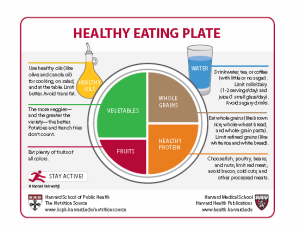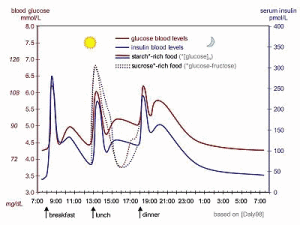Angel Sugars are Multicolored
 Angel sugars are all-natural, multicolored foods such as fruit, vegetables, legumes or nuts. The naturally occurring carbohydrates (sugar and starch) are only slowly absorbed into the blood. These multicolored angel sugars should be preferred items in your daily menu. Learn why in this article!
Angel sugars are all-natural, multicolored foods such as fruit, vegetables, legumes or nuts. The naturally occurring carbohydrates (sugar and starch) are only slowly absorbed into the blood. These multicolored angel sugars should be preferred items in your daily menu. Learn why in this article!
In contrast, devil sugar foods, which have been industrially processed such as squeezed (apples to apple juice), dried (dried fruit), concentrated (syrup), extracted (sugar), peeled (white rice) or ground (white flour), contain concentrated amounts of carbohydrates. This sugar enters the bloodstream rapidly. You should sparingly consume foods with these types of ingredients.
Angel Sugars are:
- Fruit, fresh or frozen, is highly recommended. You should prefer old fruit varieties that have not been cultivated for sweetness (e.g. apples such as Alkmene, Boskoop). Avoid dried fruit because the percentage of sugar is highly concentrated through dehydration (100 g of grapes contain ca. 75 kcal, 100 g raisins (dried grapes) contain almost 300 kcal). Place dried fruit (e.g. for muesli) before use in water.
- Vegetables should be enjoyed in all colors and varieties. The more, the better. Potatoes do not count as vegetables!
- Legumes such as peas, beans, lentils, chick peas, clover, lupines, soja beans or peanuts all release their carbohydrates slowly.
- Nuts are not only a good snack in-between, but can also enrich muesli, salads and other dishes.
- Whole grain products should be served in the amounts recommended by the Harvard Medical School (see below).
- Snacks do not have to be eliminated. Alternative angel sugars such as xylitol, stevia or inulin are a healthier sweet temptation.
The Harvard Medical School recommends the daily consumption of 7-9 portions of fruit or vegetables. One portion is what fits into a cupped hand. You should distribute the 7-9 portions throughout the usual three meals. In the evening, you should eat low carbohydrate salads and avoid bread, pizza, rice, potatoes, sweets, etc. Snacking between meals should be an exception.
Tip: Start your day with a carbohydrate rich breakfast with lots of fruit. Try to minimize carbohydrates after 04:00 pm. Prefer carbohydrate poor foods for dinner or occasionally skip the evening meal. Drink abundantly, preferably pure water. Cater the portion sizes of the various food groups (carbohydrates, proteins, fats) according to the recommendations of the Harvard Medical School:
Why should you prefer Angel Sugars?
Carbohydrates are an essential basis for a well-balanced diet as they are a valuable energy source. They are contained in many foods as sugar or starch. Carbohydrates are absorbed in your intestine and increase your blood sugar level according to the absorption rate. Numerous scientific studies seriously advise that the blood sugar level in children and adults, and especially pregnant women, should be held as constant as possible. Regular sugar highs in the blood after meals and frequent carbohydrate input in the form of snacks or soft drinks can be like throwing grit into the works of your body and result in overweight, accelerated aging, sugar-related diseases (diabetes), cardiovascular diseases and cancer.
Devil Sugar doesn’t make you fit; it makes you tired!
Your body avoids a high blood sugar level with the release of insulin. However, this results in a rapid decrease of your blood sugar level and results in hunger attacks within two to three hours. Your performance is reduced. If you counter these hunger attacks with renewed food input, you run the risk of consuming too many calories. Weight gain may be the result. The following diagram illustrates these types of sugar and insulin highs.
Industrial processing can turn an originally healthy food into a devil sugar
The problem is not the carbohydrates by themselves, but the amount and form in which they are contained in food. Industrial processing results in the consumption of larger amounts of carbohydrates that are more quickly absorbed into the blood than the body can deal with. It is irrelevant whether the food is organically grown or not. Concentrated carbohydrates are also not suitable for your body even if they are grown organically. Of particular concern are:
- the addition of sugar and starches in our diets as a result of modern, industrial processes,
- the addition of sugar in products which are believed to contain no sugars,
- as well as the constant availability of sugar-rich products.
The type and quantity of carbohydrates which you eat determine whether they act as an energy source or sand in the works of your body.
Carbohydrates occur either isolated or in chains
The cornerstone of carbohydrates which rapidly raises the blood sugar level is glucose. In addition, there is fructose and galactose. The latter two must first be processed in the liver and therefore do not contribute as rapidly to an increased blood sugar level. Dextrose contains glucose in isolated form (monosaccharide). Therefore, it can be quickly absorbed by the intestines. Thus, dextrose belongs to the unhealthiest of all devil sugars. Table sugar (saccarose), also known as industrial, crystal, beet, or cane sugar, consists of two molecules (disaccharides), namely fructose and glucose. Another disaccharide, known as maltose, consists of two molecules of glucose. Lactose consists of glucose and galactose.
Plants can also build long chains of glucose and thus store energy. These chains are called starches. They occur among other things in cereals, rice and potatoes. You notice that, for example, when you chew bread for a long time. Saliva breaks down the long sugar chains and sets glucose free. This produces the sweet taste. But this is also exactly what causes the high blood sugar levels that we actually want to avoid. This is particularly true when we are dealing with industrially processed products, in which the starch core is isolated, such as with white flour or husked rice. That is why it is recommended not to eat too many foods made from grains (bread, noodles, cookies, breakfast cereals, etc.), rice or potatoes, and if so, whole grain products should be prefered. Especially problematic is, for example, when the long sugar chains have been shortened during the making of potatoes into mashed potatoes. The resulting glucose is quickly absorbed into the intestine. The consumption of carbohydrates in combination with fats slows the sugar absorption rate. This is also true when rice or potatoes are allowed to cool before eating (e.g. potato salad). The Harvard Healthy Eating Plate gives you an indication what percentage of your diet should come from whole grain products.
Syrup is often assumed to be a healthy alternative sweetener. “In cooking, a syrup is a thick, viscous liquid consisting primarily of a solution of sugar in water, containing a large amount of dissolved sugars… Syrups can be made by dissolving sugar in water or by reducing naturally sweet juices such as cane juice, sorghum juice, or maple sap. Corn syrup is made from corn starch using an enzymatic process that converts it to sugars.“ (from: http://en.wikipedia.org/wiki/Syrup). Even if the syrup is a result of biological processes, syrup is nothing other than sugar with the same disadvantageous effects.
Many believe that fructose cannot be so bad because it occurs naturally in fruit. Here the problem arises as a result of concentration through industrial processing. Fructose in fruit occurs in substantially lower concentrations than in industrial products. In addition, fructose is a sugar substitute which can be made cheaply from corn and is often used in soft drinks, sweets and diet products. There is much to indicate that the dosage of fructose in the products just mentioned are responsible for overweight, sugar diseases (diabetes), metabolic syndrome, gout, high blood pressure, or cirrhosis of the liver.
What makes Angel Sugars Special?
The building blocks of good and bad carbohydrates are the same. Angel sugars are, however, foods in which the sugar building blocks only occur in low concentrations and are bound in such a way that they are only slowly absorbed into the blood. Good carbohydrates only raise the blood sugar level slightly, or not at all, and the counter reaction of insulin is either weak or non-existent. Thus, the satiation effect lasts longer. The impulse to eat in between is reduced. Tiredness is not a result. Fruit, vegetables, legumes and nuts are the most important sources of these carbohydrates. In addition, they contain vitamins, which are necessary for the processing of sugars and numerous metabolic functions, as well as dietary fibers.
Alternative Angel Sugars
 You don’t need to completely abstain from chocolates and other sorts of sweets. There are alternatives. These are carbohydrates which cannot be split or absorbed in the mouth, stomach, or the small intestine. The sugar substitute Xylitol (extracted from birch bark or corn) belongs to the sugars which aren’t processed by intestinal bacteria until they reach the large intestine. Xylitol has the same sweetness as table sugar. In addition, Xylitol reduces mouth bacteria responsible for tooth decay. Finnish studies indicate that Xylitol can protect teeth from tooth decay if 2-3 g are taken 2-3 times daily after brushing the teeth. Furthermore, children who eat Xylitol, suffer less from middle-ear infections. Protection against osteoporosis in adults is also being discussed. Chew more often chewing gum containing Xylitol, suck on a piece of Xylito candy or keep some Xylitol powder in your mouth for 2-5 minutes after brushing your teeth. Use Xylitol for baking or cooking. Your children will like it and will avoid other sweets. Xylitol has slight laxative effects.
You don’t need to completely abstain from chocolates and other sorts of sweets. There are alternatives. These are carbohydrates which cannot be split or absorbed in the mouth, stomach, or the small intestine. The sugar substitute Xylitol (extracted from birch bark or corn) belongs to the sugars which aren’t processed by intestinal bacteria until they reach the large intestine. Xylitol has the same sweetness as table sugar. In addition, Xylitol reduces mouth bacteria responsible for tooth decay. Finnish studies indicate that Xylitol can protect teeth from tooth decay if 2-3 g are taken 2-3 times daily after brushing the teeth. Furthermore, children who eat Xylitol, suffer less from middle-ear infections. Protection against osteoporosis in adults is also being discussed. Chew more often chewing gum containing Xylitol, suck on a piece of Xylito candy or keep some Xylitol powder in your mouth for 2-5 minutes after brushing your teeth. Use Xylitol for baking or cooking. Your children will like it and will avoid other sweets. Xylitol has slight laxative effects.
Another example is Inulin, which consists of a long chain of fructose building blocks, which are tightly bound with one another. Inulin can broadly be considered to belong to the dietary fibers und is also known as prebiotic. Only in the large intestine can Inulin be broken down by intestinal bacteria where the Inulin is transformed into short-chain fatty acids ( SCFA). According to its preparation, blood sugar and insulin levels are only marginally influenced. Inulin is therefore also suitable for diabetics. Foods rich in Inulin are Jerusalem artichokes, chicory roots, artichokes, black salsify or parsnips. Increasingly it is being used in foods such as yogurt or as a fat substitute in sausage products or sweets. Inulin has, depending on its form, 30-50% of sugar’s sweetness.
A special sugar is Isomaltulose (Palatinose). This double sugar consists of glucose and fructose, whose bond is stronger than cane sugar. Therefore, Isomaltulose takes longer to break down in the intestine. Consequently, blood sugar levels also rise more slowly. Bacteria responsible for tooth decay cannot use Isomaltulose. Isomaltulose only has a slight sweetening effect.
A natural sweetener with 300 times the sweetness of table sugar is Stevia. However, it is extracted through a complicated chemical process. This has little to do with all-naturalness. Stevia has an unpleasant taste. Therefore, it is often mixed with other sweeteners.
Sugar substitutes such as Isomalt, Mannit and Sorbit are increasingly used in sweets. They deliver less energy and have only slight effects on blood sugar and insulin levels. Bacteria responsible for tooth decay cannot use these sugars. Sugar substitutes have a slight laxative effects.
Help yourself to multi-colored Angel Sugars!!!




